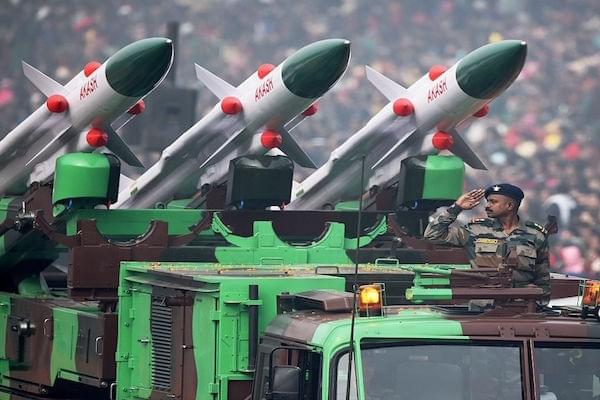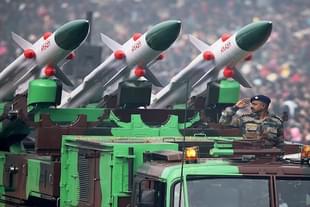Defence
Why India Should Step Up Arms Sales To Latin America
Dr. Sanjay Badri-Maharaj
Jul 13, 2016, 01:37 PM | Updated 01:37 PM IST
Save & read from anywhere!
Bookmark stories for easy access on any device or the Swarajya app.


As India embarks on a quest to boost its currently paltry arms exports, the Latin America-Caribbean region offers India both markets and potential partnerships.
India is not a stranger to the Latin America-Caribbean arms bazaar, and its efforts have been rewarded with some successes, with vehicles and helicopters securing sales among the region’s military and police forces. Nonetheless, these sales represent but a small step, and there is considerable potential for both enhanced sales and joint ventures in the defence sphere.
Among the successes, there have also been embarrassing quasi-failures which, while not fatal to India’s desire to enhance defence exports in the region, have demonstrated the need for a more systematic and coordinated approach with appropriate support from the Indian Government and financial institutions.
India’s trade with Latin America-Caribbean has grown at roughly the same rate as China’s in the twenty-first century, though its volume is ten times less. However, India’s defence relationship with the region is relatively static and, compared to China’s determined push to forge links with the military leadership in the region through bilateral contact and training as well as arms sales, has been much more reticent.
India has so far taken very tentative steps to strengthen military-to-military relations and its arms sales to the region. While this may be understandable given that there are capable arms industries in several countries – Brazil, Chile, Peru and Colombia (with Argentina maintaining prowess despite a decline in its indigenous defence manufacturing) – with well-developed military education systems too, there is ample scope for enhanced cooperation and arms sales to the smaller nations of the region which lack such facilities, and which have pressing needs that can benefit from Indian support, financial assistance and possible equipment transfers.
Even the larger countries may see a benefit in forging partnerships and joint ventures with the Indian companies.
The Latin America-Caribbean region includes the tiny islands of the Caribbean, many of which are English-speaking, the Guianas – Guyana, Suriname and French Guyana – and the small nations of Central America, south of Mexico. In all of these countries, India has much to offer in respect of training, equipment (lethal and non-lethal) and overall security cooperation. Indeed, as the potential for pirate attacks increases in the region and the spectre of terrorism looms large, Indian expertise in these spheres could be of considerable interest to the region.
Furthermore, the United Nations (UN) peacekeeping operations provide the opportunity for enhanced cooperation as Brazil, Uruguay, Argentina and Colombia have contributed extensively to the UN peacekeeping forces worldwide. The armed forces of smaller Caribbean countries such as Trinidad & Tobago and Jamaica served with distinction during peacekeeping operations in Haiti. In the quasi-related spheres of disaster management and humanitarian assistance, Latin American and Caribbean forces routinely undertake such activities and could again benefit significantly from the Indian experience in this regard with the exchange of personnel and exercises. This would inevitably lead to a higher Indian defence profile in the region, possibly facilitating Indian defence sales in due course.
In stark contrast to China, India’s military training links with the region are limited. China has actively encouraged officers from the region to attend its training schools for specialised and staff training.
India has not accorded sufficient priority to the same with an attendant absence of presence and profile in the region. China’s policy of encouraging military training links has built up a cadre of officers who may now be open to considering the purchase of Chinese weapons, and it may be no coincidence that China’s arms sales to the region have soared.
These sales have been supported by a sustained Chinese diplomatic effort, which has targeted not just military stipulated requirements but also the political leadership of certain countries, such as Argentina, Bolivia and Venezuela, who have been amenable to Chinese arms sales as a way of asserting independence in an area hitherto dominated by the influence of the United States (US).
India’s arms sales, to the Latin America-Caribbean region, by way of comparison, have been limited and represent a combination of commercial sales through private sector companies and sales from the Indian defence public sector undertakings (DPSUs). It does not seem, however, that these sales were part of a cohesive arms export drive in the region. In the absence of the required diplomatic and banking and possibly support from the Indian financial institutions, the scope for expanded sales is not as promising as it might otherwise be.
Among the more prominent sales of Indian defence products in the region have been:
- The sale of two Mahindra Rakshak armoured vehicles and one Mahindra Rapid Intervention Vehicle to Guyana Police Force
- 139 Ashok Leyland 4×4 trucks to the Honduran Army
- Mahindra 4×4 vehicles to Argentina, Uruguay and Belize
- 29 Mahindra Marksman vehicle to the Chilean Carabineros Special Forces
- Two civil model Dhruv helicopters to Peru
- Seven Dhruv helicopters to Ecuador (now withdrawn from use following accidents)
- Three Chetak helicopters to Suriname
These sales are modest but not insignificant. However, two sales have been plagued by some degree of controversy, occasioned in part by poor post-sales support and poor contract coordination with the purchaser. The sale of Dhruv helicopters to Ecuador was widely hailed, and rightly so, as a major breakthrough for Indian arms export. However, after a number of crashes (several of which were caused by pilot error), the helicopters were withdrawn from use, citing, among other things, poor spares support from Hindustan Aeronautics Limited (HAL).
The sale of Chetaks to Suriname was plagued by poor contract management and “financial and administrative obstacles”, which led to the helicopters being ready long before pilots were ready to be trained, leading to a delay in delivery of the helicopters.
In addition, an apparent disconnect between the user and the supplier in negotiating the contract led to Suriname acquiring Chetaks rather than the Dhruvs that they reputedly preferred. It should be noted that on this latter point, HAL always seemed clear that it was selling Chetaks to Suriname rather than Dhruvs, but the issue remains a point of minor contention between the parties.
Even the sale of the Mahindra Marksman to Chile has had its share of controversy as a litany of complaints about poor visibility, security flaws and off-road performance have been levelled at it, and it is not known if Mahindra & Mahindra is working on any remedial steps to overcome the criticism.
In none of the above cases has the Indian Government been the prime mover, providing support, reassurance and a method of informal dispute resolution to prevent minor issues becoming major ones. This was despite the fact that Suriname used US$ 13 million from a US$ 16 million Indian line of credit to make the purchase. Little interest was thereafter shown in making the procurement flow smoothly, with “financial and administrative problems”, as stated earlier, playing a part in delaying the delivery of the helicopters. In fact, it was the proactive approach of the Indian ambassador to Suriname that enabled the delivery of the Chetaks and its acceptance by the Suriname Government. Had a similar proactive approach been followed in Ecuador and Chile, the issues and concerns raised by the customers could have been dealt with without acrimony.
This confused and somewhat half-hearted approach to defence sales to the Latin America-Caribbean region is hindering Indian efforts to raise its global profile. It is also noteworthy that the US, though uncomfortable with China’s profile in the region, has not objected to it strenuously. It is, therefore, unlikely to be hostile to a greater Indian presence in the region.
The way forward is clear: India must accord priority to its defence ties with the region. More defence attaches are needed, and Indian defence sales must have Delhi’s full political and diplomatic support. In addition, Delhi should consider monitoring projects or sales in which DPSUs are involved. Moreover, tie-ups with regional defence companies should be encouraged, with COTECMAR of Colombia and ASMAR of Chile being potential partners for Indian shipyards and Embraer of Brazil having the potential for joint ventures with HAL.
While India has not taken the initiative to date, there is an unrealised potential that should be acted upon as India seeks to forge international partnerships and increase its global clout.
References
Evan Ellis, “Time to talk about India and Latin America”, Latin America Goes Global, 8 June 2015 (Accessed 30 June 2016)
Michael Pelzer, “Bullets From Brazil: Growing Military Industrialism in Latin America”, WOLA, 21 March 2014 (Accessed 30 June 2016)
Gabriel Marcella, “China’s Military Activity in Latin America”, Americas Quarterly, Winter 2012 (Accessed 30 June 2016)
Evan Ellis, “Should the U.S. be worried about Chinese arms sales in the region?”, Latin America Goes Global, 11 May 2015 (Accessed 30 June 2016)
Kamilia Lahrichi, “China’s Growing Military Sway in Latin America”, Asia Sentinel, 4 August 2014 (Accessed 30 June 2016)
“More vehicles for the Police Force”, 27 August 2005 (Accessed 3 July 2016)
“US$ 10.5mn order for Ashok Leyland from Honduras”, Business Standard, 12 January 2009 (Accessed 3 July 2016)
Evan Ellis, n.1.
Praveen Bose and Ravi Menon, “HAL secures copter order from Peru”, Business Standard, 24 June 2008 (Accessed 3 July 2016)
“Ecuador cuts Dhruv helicopter contract with HAL after 4 crashes”, The Times of India, 16 October 2015 (Accessed 3 July 2016)
“India Gives 3 Chetak Helicopters to Suriname”, Defense-Aerospace.com, 16 March 2015 (Accessed 3 July 2016)
Gustavo Villarrubia and Juan Pablo Figueroa, “Carabineros spends US$ 3.5 million in armored cars that have serious security flaws”, CIPER, 21 August 2013 (Accessed 3 July 2016)
This piece was first published on Indian Defence Review and has been republished here with permission.
Dr. Sanjay Badri-Maharaj is a lawyer practicing in Trinidad and Tobago, has a PhD from King’s College London on India’s nuclear weapons program and the author of The Armageddon Factor – Nuclear Weapons in the India-Pakistan Context.





